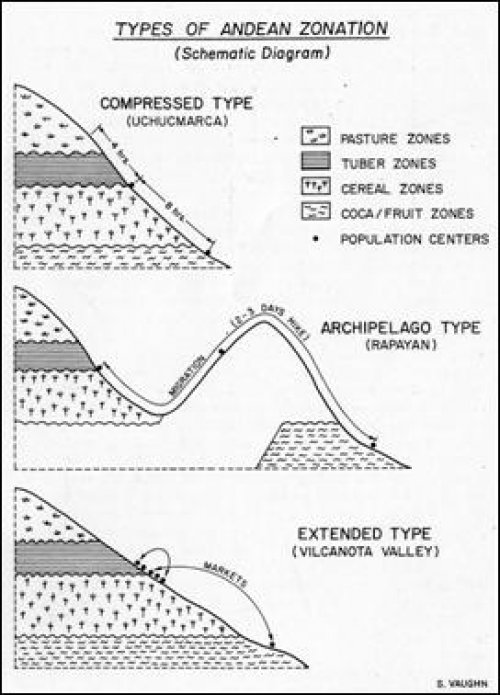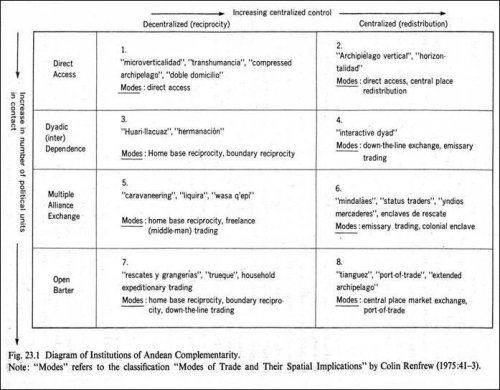Verticality writ large
Vertical complementarity encompasses a variety of strategies for the problems posed by human use of resources at different scales, and by the broad natural diversity across relatively small distances in mountain environments (Aldenderfer 1993;Masuda, et al. 1985). These problems of articulation are addressed through mobility, through direct control of different zones by a single group, by mutualism between residents of different zones, and through a variety of exchange relationships. Vertical organization has been recorded among modern Quechua and Aymara communities (Brush 1976;Brush 1977;Flores Ochoa, et al. 1994;Harris 1982;Harris 1985;Platt 1980).
Figure 3-2. Contemporary types of Andean zonation (Brush 1977: 12 ).
Based on contemporary observations, Brush (1977: 11) describes three systems:
- the archipelago type, or vertical complementarity, as conceived by Murra;
- a compressed type, where a single village can access and control all resources without resorting to means of long distance control;
- the extended type that corresponds to horizontal complementarity.
On a more localized scale it is possible to see vertical control strategies within a particular valley in a mixed agropastoral strategy that has been called "compressed archipelago" (Figure 3-2). In the central part of the Colca valley on the western slope of the Andes in Arequipa, Peru, Guillet describes vertical household relations.
To what extent do households integrate both puna pastoralism and valley farming into their production and exchange strategies? First, most households residing in the puna tend to specialize in herding and do not have agricultural fields that they cultivate directly. Similarly, many village households neither belong to family surname groups with access to puna pastures nor count themselves among those who have gained control of communal pastures ( botaderos) on the slopes behind the village. Households that follow such specialized strategies must perforce use the exchange nexus to obtain complementary products (Guillet 1992: 133).
Additional evidence for micro and macro vertical complementarity is discussed in the context of the Colca valley (Casaverde Rojas 1977: 172;Málaga Medina 1977: 112-113;Pease G. Y 1977;Shea 1987: 71).
Vertical complementarity can viewed as an anthropological principle that describes the propensity for social groups in mountain environments, from foragers to state societies, to geographically broaden their social and economic base and reduce risk by exploiting a variety of environmental settings (Aldenderfer 1993;Guillet 1983;Salomon 1985). Salomon (1985: 520) presents complementarity strategies in prehispanic Ecuador as varying in two dimensions.
Figure 3-3. Diagram of institutions of Andean complementarity (from Salomon 1985: 520). Numbered modes reference the "Modes of Trade" in the figure from Renfrew (1975: 41-43 ) shown in the previous chapter as Figure 2-2.
One is between decentralized systems based on reciprocity, and the other is based on centralized systems of redistribution. There is an underlying neo-evolutionary correspondence implied in many of these models, as chiefdoms and states are believed to have been responsible for the network convergence perceived in redistributive systems, however it is important to observe that due to the variety in products, social relationships, and economic configurations, it is likely that a great many of the institutions presented in Figure 3-3 occurred simultaneously, and in general there is no direct correlation between confluence and evolutionary typologies. Another important dimension involves the number of political units participating in the interaction ranging from direct access, dyadic relations, exchange systems and open barter. The vertical complementarity literature in the Andes is valuable for considering prehispanic exchange relationships in that it has compelled a number of scholars to explore explicitly the relationship between ecological zonation, production, and social organization.


